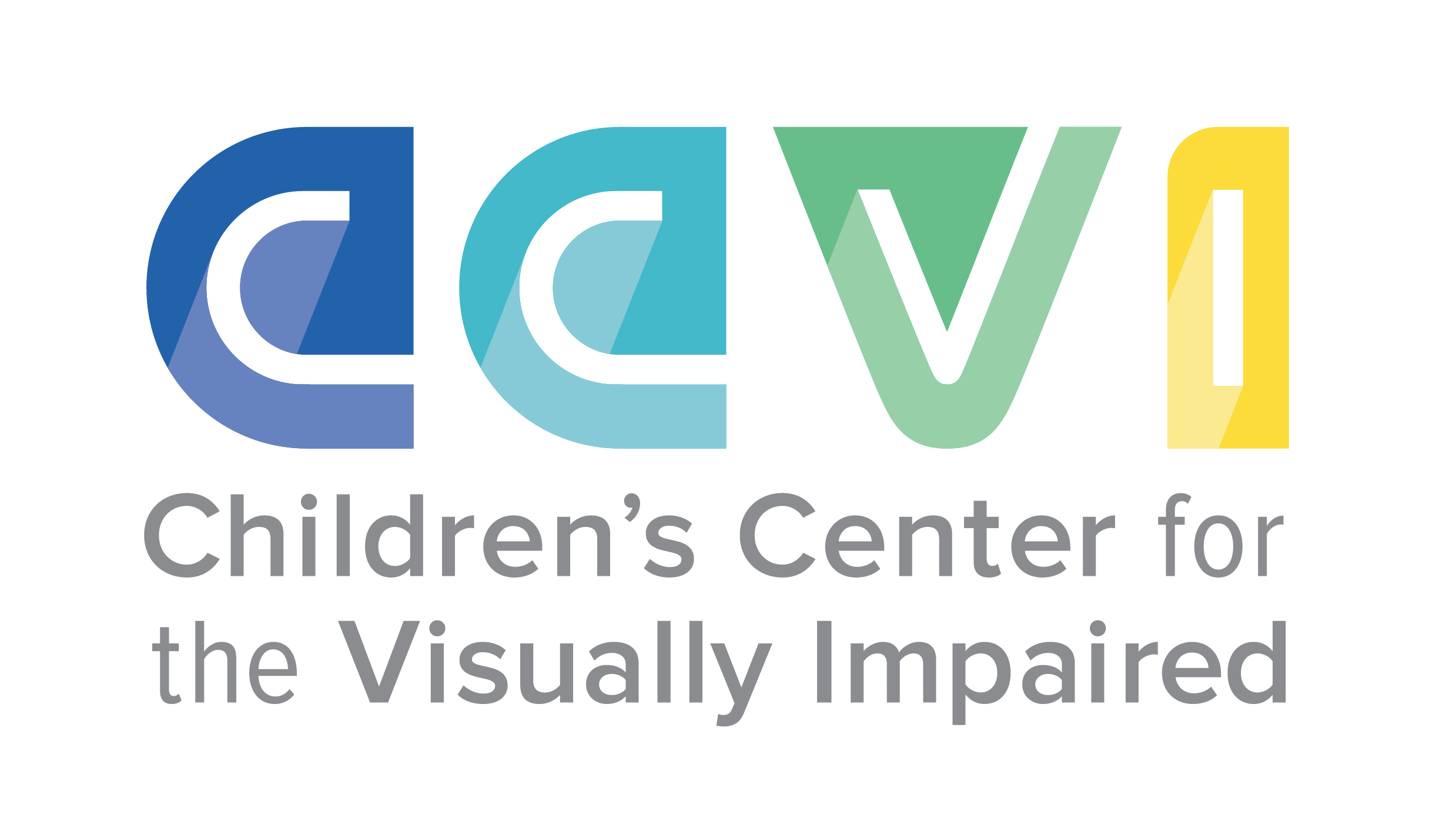
A path to growth
overview
For any adventure, it helps to have a map. Children’s Center for the Visually Impaired is able to provide that guide for parents, medical professionals, educators, and many others to reference during a child’s educational journey. Certified Teachers of the Visually Impaired, therapists, and specialists work together to build comprehensive evaluations for children with visual impairments. Whether it’s a one-time assessment or the beginning of 6-year-long partnership of service, vision evaluations can be a beacon of hope for families with a newborn or a child making their way through the educational system.
Professional evaluators with complex understandings of common and uncommon diagnoses can use techniques to establish a baseline for a child’s vision capacities and document recommendations for how their educational plan in the future should be influenced by their low vision needs. Download our Evaluation Team’s bios!
Who can receive an evaluation?
Any child can receive an evaluation from CCVI no matter the age.
For children who are enrolled in CCVI’s Early Intervention Program or Preschool Program, evaluations are conducted and updated frequently based on the diagnosis and learning plan.
Visual Evaluations at CCVI, whether a Functional Vision Evaluation or a Learning Media Assessment, are often used in conjunction with a child’s Individualized Educational Program (IEP). Therefore, all aspects of a child’s diagnosis or diagnoses are considered. Since CCVI serves children with multiple disabilities, Teachers of the Visually Impaired on staff have experience working with, evaluating, and educating children across the developmental spectrum.
For parents of a child with special needs, contact CCVI to have a conversation about your needs and how professionals can help.

Outreach and Referrals
CCVI partners with childhood care providers throughout Missouri and Kansas. Staff professionals conduct vision evaluations with or without referrals to identify the range of vision and Teachers of the Visually Impaired provide learning media assessments at an early age to ensure the child has the appropriate tools for compensatory purposes.
Make a difference and advocate for a child by learning more about CCVI’s partnerships.
It all starts with you.

Functional Vision
Evaluations
Visual Impairments come in many different forms across a wide spectrum of vision capabilities, whether an individual can just perceive light or has enough vision to travel unaided. Following a diagnosis of a visual impairment, a common question parents have is, “How much can my child see?” A Functional Vision Evaluation seeks to provide the answer. Performed by a Teacher of the Visually Impaired, this evaluation helps identify the range of vision by using an organized playtime to observe the child’s behavior. Professionals in the field can identify vision abilities based on the collected data.
WHY RECEIVE A FUNCTIONAL VISION EVALUATION (FVE)?
This initial assessment is the pavement beneath the feet of a child’s educational path forward. A formal evaluation typically takes an hour, and it influences curriculum and services for years to come. It allows teachers, parents, and every individual involved in the developmental process to collaborate and devise strategies for the most efficient learning plan. Experts at Children’s Center for the Visually Impaired can assess essential functions, such as cognition, communication, motor and vision-related compensatory skills, and provide a comprehensive evaluation.
WHAT COMES NEXT?
The initial Functional Vision Evaluation sets the baseline for visual functioning and provides strategies to incorporate into a home and educational setting to allow a child to perform at the same level as their sighted peers. The FVE provides insight into the visual needs of the child in relation to their participation in the educational environment and how it needs to be adapted. From there, the team begins to formulate goals and identify areas of need and opportunities for growth for the child.
WHAT DOES A VISUAL EVALUATION LOOK LIKE?
The FVE looks similar to play. There are specific visual skills being assessed, often times without anyone else noticing. A Teacher of the Visually Impaired performs the evaluation. It takes approximately an hour, but every child is different. Throughout the evaluation, parents and caregivers answer interview questions relating to the child’s visual behavior in the home or school setting. Following the evaluation, the evaluator will give recommendations and answer questions about the educational implications of a child’s diagnosis. They will also explain possible service options and what that might look like depending on the age of the child.
how to pay for a vision evaluation?
For many cases, the cost of the vision evaluation is covered by the referral source. School districts often partner with CCVI and contract the organization’s professionals to perform the evaluation. Medical referrals coming from hospitals or clinics also have coverage options available through partnerships to ensure families receive the information they need to move forward with their diagnosis. For families without a willing referral source, a parent or guardian should contact CCVI to find out about the cost of the evaluation and what support is available.

Learning Media
Assessments
A Learning Media Assessment (LMA) often takes place at some point following a Functional Vision Evaluation. This session is used to select the appropriate resources to surround a child with, based on their vision capacity, in order to enhance their learning through media. Whether conducted by an individual Teacher of the Visually Impaired or a team of medical, educational, and therapeutic professionals, this assessment determines whether a child is best suited to experience literary content through braille, print, auditory methods, or objects.
In addition to literacy recommendations, evaluators will also provide and consider strategies for two-way communication. This method enhances the educational process and can be integrated into the child’s curriculum through their Individualized Educational Program, whether their home district provides services or the child formally attends CCVI. An LMA assesses the student’s preferred learning style, which elevates the tactics future teachers can implement.
does CCVI provide learning media assessments for schools?
CCVI can be used as a contracted resource for school districts to evaluate the needs of a student. With certified Teachers of the Visually Impaired (TVIs), CCVI will partner with the child’s home district to provide recommendations for learning and reading. The results of the evaluation can be implemented into the child’s Individualized Educational Program (IEP) and incorporated into curriculum. After the Functional Vision Evaluation and/or the Learning Media Assessment, CCVI might recommend to the school district that the child incorporates assistive technology or readers into their every day life.
do learning media assessments take other disabilities into account?
Just like a Functional Vision Evaluation, Learning Media Assessments look at the holistic picture of a child’s capabilities. Therefore, additional obstacles of educational learning needs are always observed and accounted for. For example, a student with difficulties in their fine motor skills might struggle with reading Braille even though their vision alone would suggest it as a suitable method. Therefore, Teachers of the Visually Impaired at CCVI dive into the preferred sensory channels of a child. This allows the assessment to be more comprehensive and inclusive to children of all abilities.
What technologies can be utilized after a Learning media assessment?
Learning Media Assessments have adapted throughout the course of the technological boom. While traditional post-assessment recommendations, such as Braille, are still common, there are many other compensatory methods that Teachers of the Visually Impaired will recommend. For example, many students that are referred to CCVI have multiple disabilities. For some, this means that assistive technology might be beneficial. These communication switches can work alongside a screen reader to digitally help a student converse with their parents, peers, or teachers.

Assistive Technology
Assessments
Augmentative and Assistive Communication Evaluations
Orientation and Mobility Evaluations
Other evaluations
Assistive technology Assessments
An ongoing and dynamic assessment, students are matched with technological resources that appropriately close the gap between their low vision deficits and typical lesson plans. CCVI staffs an assistive technology specialist to perform the assessment and students can trial different equipment to best meet their needs. In some cases where communication is a concern, students can also receive an augmentative and assistive communication evaluation.
Augmentative and Assistive Communication Evaluations
Visual Impairments often provide communication challenges, especially for young children. In order to provide better resources for relationship building, a speech-language pathologist or an assistive technology specialist can perform an augmentative and assistive communication evaluation. This assessment analyzes basic language concepts and literacy in order to match specific tools to a child’s needs.
Orientation and Mobility Evaluations
Orientation and Mobility Evaluations are conducted by a Certified O&M Specialist to observe a child’s movements and understanding of positioning in order to provide recommendations for how they can navigate different environments safely. The assessment begins with the specialists gaining a proper history about the child’s diagnosis, functional vision, and current state of movement. After the observation, the specialist can identify and test where deficits may be, as it relates to traveling. For example, a specialist could assess the child’s knowledge of body awareness. Follow up recommendations can include cane training, environmental alterations in the home, or tips for transportation.












